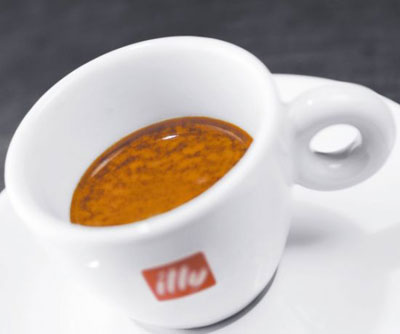The production of Espresso is a technical task. The importance of Espresso matching.
Production of Espresso: matching
Generally speaking, large coffee beans can produce better coffee. In the case that the quality of coffee beans has been fully assured, the first technical problem to be solved is "blending". "blending" refers to the selection of coffee beans of different origin and quality to achieve the desired results. The "matching Technology School" believes that 50% of the success factors of a perfect Espresso depend on the composition and quality of the match. No single-origin coffee can fully achieve the taste required by Espresso. Coffee beans from African and Arab coffee trees are characterized by complexity, large amount of berries and floating aroma, while coffee from Latin America is clean, strong and refreshing, while coffee from Southeast Asia is characterized by full fruit and earthy flavor. Many coffees are a mixture of several types of coffee, making the taste more complex.

The Espresso boiled at the ideal water temperature is dark reddish brown, with dark brown spots on the surface of the foam (called "el tigre" by the Italians), and the foam should be more than 4mm thick.
A perfect match is not a random mix of several boutique coffee beans. The basic blending process is to first determine the benchmark beans, then add coffee beans that can increase flavor and special flavor, and form a blend of coffee according to the mixing proportion and roasting degree of all kinds of beans. Raw beans for blending should have their own characteristics to avoid similar flavor. The quantity and proportion of coffee beans depends on continuous attempts, so most of them draw up a matching schedule by mathematical combination before blending, and then determine the best plan through the process of assembling cups.
Bake before matching, or match before baking? This has always been a topic of debate between bakers and assemblers. As with wine, blending before baking can make the aroma and quality more uniform, but the "decay" of roasting must be taken into account, as coffee from different places requires different baking time and temperature. If you have a definite recipe, you can put different coffee beans together and then bake them together. Most long-established coffee makers have their own secret recipes.
In contrast to the "blending technology school", the "baking technology school" believes that the taste of coffee depends 80% on roasting. Regardless of the percentage data, whether you are particular about the degree of "roasting" and whether you bake it yourself, this has indeed become an important indicator to verify the identity of a coffee glutton. "roasting" refers to roasting the raw coffee beans with a special machine to make the coffee beans show a unique brown color, aroma and taste. The key point is to "stir-fry" the inside and outside of the beans evenly without being overburnt. A series of chemical changes occur during baking: moisture decreases from 10% to 1%, fat from 12% to 16%, sugar from 10% to 2%, chlorogenic acid from 7% to 4% to 5%, and nitride from 12% to 14%. The physical change is: water loss, weight reduction of 10% to 15%, volume increase of 60%.
A vivid analogy is: "the roaster is a machine between a popcorn machine and a clothes dryer." The temperature in a large industrial baking bucket can reach 288 degrees Celsius, and the coffee beans first turn yellow and smell like popcorn. After about 8 minutes, it began to snap and expand, and when the temperature reached 204 degrees Celsius, the coffee beans began to turn brown and the oil began to spill out. The spilled oil is called "caffeine" or "caffeine", and the chemical reaction between calories and caffeine is called "pyrolysis", which produces a strong coffee flavor. In another 3 to 5 minutes, there will be another snapping sound in the machine, and the color of the coffee will soon change to a dark color, indicating that it has been baked. When the preset baking temperature is reached, cold air can be used to stop baking. The well-roasted coffee beans have no wrinkles on the surface and the gloss is symmetrical, which fully demonstrates its unique flavor. If you are too impatient at the beginning of baking, there will be spots on the bean skin and the taste will become bitter and choking.
In 1992, the second generation of Yili managers commissioned architect Matteo Thun to design a set of white coffee porcelain cups, which gave birth to a series of popular Italian coffee collection cups. Every year Yili invites modern artists to work together to design the annual collection cup. Despite the ever-changing exterior decoration, the cup itself has always strictly followed the Italian family's definition of the perfect Espresso coffee cup: "A small thick-walled porcelain cup with a capacity of no more than 50ml." Small capacity to ensure that the drinks are more concentrated; use synthetic materials to ensure that the foam and liquid parts are as clear as the liquid. "
Generally, roasting is divided into shallow, medium and deep degrees, and the baking time varies depending on the type of coffee required. The light roasted coffee beans are light and sour, the intermediate roasting is sour and bitter, and the deep roasting color is rich and bitter. The lighter the roasting degree is, the stronger the sour taste of the coffee bean is, the deeper the baking degree is, the sour taste is gradually lost, and the bitterness is heavier. Professional baking methods are usually divided into the following eight stages: very shallow baking (Light Roast), shallow baking (Cinnamon Roast), micro baking (Medium Roast), medium baking (High Roast), medium and deep baking (Cicty Roast), deep baking (Full-City Roast), very deep baking (French Roast) and very deep baking (Italian Roast). Deep baking, also known as "Italian baking", is mainly popular in Latin countries and is considered to be the most suitable for Espresso. The color of the very deep-roasted coffee beans is black, and the oil has infiltrated to the surface, so it has a bitter taste of carbon ash, and the mellowness is significantly reduced.
For some strict baking techniques, roasted coffee used in Espresso should also be fresh, so coffee roasted within four days is required. But I'm afraid this rule only applies to gluttons who bake on their own small machines. Big coffee factories have a variety of patented technologies to ensure the sealed preservation of roasted coffee beans, the more famous of which is Illy's inert gas preservation method, which has been patented since its inception, which removes the air from the container and pours it into the pressurized inert gas. The observation under the electron microscope can confirm that coffee oil is scattered sporadically in the coffee cell tissue, and after pressure, these oils will be concentrated around the cell wall, wrapping some fragrant and highly volatile chemicals in the cells, thus isolating air contact and avoiding oxidation. The technology is believed to maintain the flavor and freshness of roasted coffee beans for up to three years.
Important Notice :
前街咖啡 FrontStreet Coffee has moved to new addredd:
FrontStreet Coffee Address: 315,Donghua East Road,GuangZhou
Tel:020 38364473
- Prev

Bailey paired with latte to make a fancy drink
Fresh Irish cream, authentic Irish Whiskey, a variety of natural spices, chocolate and Irish craft spirits, Bailey comes from the natural combination of these high-quality elements, combining all the Irish classics. Through its unique brewing technology, Bailey not only maintains the natural freshness of cream and silky taste, but also achieves perfection with chocolate and alcohol.
- Next

Espresso production is technical work Espresso coffee grinding skills
The thickness of the coffee beans depends on how they are cooked. Generally speaking, the longer the cooking time, the coarser the ground powder. In terms of actual brewing, American filtered coffee takes a long time to make, so the coffee particles are the coarsest. Siphon brewing takes about one minute, and the coffee particles are medium. Espresso takes the shortest time, so the particles that need grinding are also the most.
Related
- Beginners will see the "Coffee pull flower" guide!
- What is the difference between ice blog purified milk and ordinary milk coffee?
- Why is the Philippines the largest producer of crops in Liberia?
- For coffee extraction, should the fine powder be retained?
- How does extracted espresso fill pressed powder? How much strength does it take to press the powder?
- How to make jasmine cold extract coffee? Is the jasmine + latte good?
- Will this little toy really make the coffee taste better? How does Lily Drip affect coffee extraction?
- Will the action of slapping the filter cup also affect coffee extraction?
- What's the difference between powder-to-water ratio and powder-to-liquid ratio?
- What is the Ethiopian local species? What does it have to do with Heirloom native species?

